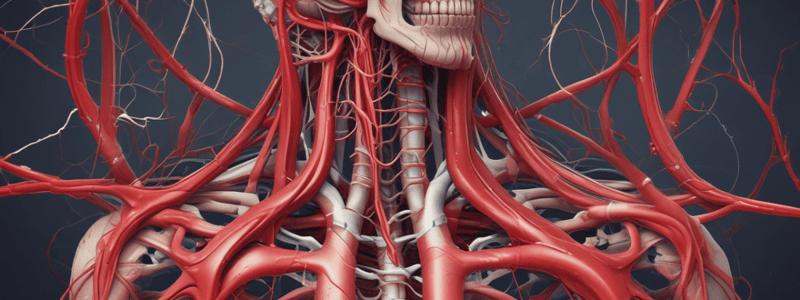Podcast
Questions and Answers
Where do the thoracic arteries supply blood?
Where do the thoracic arteries supply blood?
- From the umbilicus to the knees
- From the shoulders to the hips
- From the clavicle to the umbilicus (correct)
- From the knees to the feet
What structures lie posteriorly to the internal thoracic artery?
What structures lie posteriorly to the internal thoracic artery?
- Esophagus and diaphragm
- Trachea and bronchi
- Lungs and heart
- Transversus thoracis muscle (correct)
Which artery is considered a terminal branch of the internal thoracic artery?
Which artery is considered a terminal branch of the internal thoracic artery?
- The pericardiophrenic artery (correct)
- The axillary artery
- The brachial artery
- The radial artery
In what surgical procedure can variations in the internal thoracic artery impact the outcome?
In what surgical procedure can variations in the internal thoracic artery impact the outcome?
What is the function of the internal thoracic artery in relation to the thymus and pericardium?
What is the function of the internal thoracic artery in relation to the thymus and pericardium?
Which muscle lies lateral to the internal thoracic artery?
Which muscle lies lateral to the internal thoracic artery?
What are some common complications associated with injuries to thoracic arteries?
What are some common complications associated with injuries to thoracic arteries?
What symptoms might patients present with if they have injuries to thoracic arteries?
What symptoms might patients present with if they have injuries to thoracic arteries?
Why is it crucial to understand the anatomy and variations of thoracic arteries for CABG procedures?
Why is it crucial to understand the anatomy and variations of thoracic arteries for CABG procedures?
Which imaging technique may be required for diagnosing injuries to thoracic arteries?
Which imaging technique may be required for diagnosing injuries to thoracic arteries?
What clinical manifestations might indicate thoracic artery injuries despite the absence of external bleeding?
What clinical manifestations might indicate thoracic artery injuries despite the absence of external bleeding?
Why is the left internal thoracic artery often preferred as the conduit for CABG procedures?
Why is the left internal thoracic artery often preferred as the conduit for CABG procedures?
Flashcards are hidden until you start studying
Study Notes
Thoracic Arteries
The thoracic arteries are an essential part of the cardiovascular system, supplying blood to the anterior chest wall, from the clavicle to the umbilicus, including the sternum and breasts. These arteries are involved in several anatomical and physiological aspects, including blood supply, lymphatics, and variations.
Anatomy and Blood Supply
The thoracic arteries mainly consist of the internal thoracic (mammary) arteries. These arteries originate off the subclavian artery and descend along the lateral border of the sternum. They are located approximately 1-2 centimeters lateral to the sternal margin and travel between the transversus thoracis muscle posteriorly and the internal intercostal muscles and costal cartilages. The internal thoracic artery branches into anterior intercostal arteries at each intercostal space, perforating cutaneous branches, the pericardiophrenic artery, the musculophrenic artery (terminal branch), and the superior epigastric artery (terminal branch).
Lymphatic System and Variants
The internal thoracic artery functions to supply the anterior chest wall and the mediastinum, thymus, and pericardium. There are variations in the internal thoracic artery's origin and branching patterns, which can impact surgical procedures such as coronary artery bypass grafting (CABG). These variations include the artery arising from the subclavian artery, the left internal thoracic artery being the conduit of choice for CABG, and the artery harvesting being performed with different techniques such as pedicled or skeletonized fashion, with electrocautery or harmonic scalpel, with open or intact pleura, and with clipping the end or keeping it perfused.
Clinical Significance
Damage to the thoracic arteries can lead to significant morbidity and mortality. Injuries to these arteries are associated with brachial plexus injuries and can occur due to penetrating injuries, pleuritic pain, or complications during percutaneous coronary interventions (PCI). Diagnosis of these injuries is crucial, as patients may present with tachycardia, tachypnea, and hypotension without evidence of external bleeding or hematoma. Although rare, these injuries can result in hemothorax or require neck computed tomographic angiography (CTA) for diagnosis.
In summary, the thoracic arteries play a vital role in supplying blood to the anterior chest wall and mediastinum. Their anatomy, lymphatic system, and variations are crucial for surgical procedures such as CABG. Understanding the clinical significance of these arteries can help clinicians diagnose and treat injuries effectively.
Studying That Suits You
Use AI to generate personalized quizzes and flashcards to suit your learning preferences.




